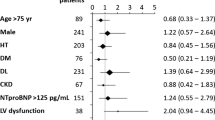Abstract
Reduced exercise capacity is known to be an important predictor of poor prognosis and disability in patients with cardiovascular diseases and chronic heart failure, and even members of the general population. However, data about exercise capacity assessed by cardiopulmonary exercise testing (CPX) in acute myocardial infarction (AMI) patients who underwent primary percutaneous coronary intervention (PCI) is scarce. Among 594 consecutive AMI patients who underwent primary PCI, we examined 136 patients (85.3% men, 64.9 ± 11.9 years) who underwent CPX during hospitalization for AMI. CPX was usually performed 5 days after the onset of AMI. Reduced exercise capacity was defined as peak VO2 ≤ 12. Clinical outcomes including all-cause death, myocardial infarction, and hospitalization due to heart failure were followed. Among 136 patients, reduced exercise capacity (peak VO2 ≤ 12) was seen in 38 patients (28%). Patients with reduced exercise capacity were older, more likely to have hypertension, and had lower renal function. In echocardiography, patients with reduced exercise capacity had higher E/e’ and larger left atrial dimension. Multivariate logistic analysis showed that E/e’ (OR 1.19, 95% CI 1.09–1.31, p < 0.001) was an independent predictor of reduced exercise capacity (peak VO2 ≤ 12). Median follow-up term was 12 months (IQR 9–22). The occurrence of composite endpoints of all-cause death, myocardial infarction, and hospitalization due to heart failure was significantly higher in patients with peak VO2 ≤ 12 than those with peak VO2 > 12 (p < 0.001). Reduced exercise capacity following primary PCI in AMI patients is associated with diastolic dysfunction and may lead to poorer clinical outcomes.

Similar content being viewed by others
References
Reed GW, Rossi JE, Cannon CP (2017) Acute myocardial infarction. Lancet 389:197–210
Anderson JL, Morrow DA (2017) Acute myocardial infarction. N Engl J Med 376:2053–2064
Levine DA, Davydow DS, Hough CL, Langa KM, Rogers MA, Iwashyna TJ (2014) Functional disability and cognitive impairment after hospitalization for myocardial infarction and stroke. Circ Cardiovasc Qual Outcomes 7:863–871
Vanhees L, Fagard R, Thijs L, Staessen J, Amery A (1994) Prognostic significance of peak exercise capacity in patients with coronary artery disease. J Am Coll Cardiol 23:358–363
Keteyian SJ, Brawner CA, Savage PD, Ehrman JK, Schairer J, Divine G, Aldred H, Ophaug K, Ades PA (2008) Peak aerobic capacity predicts prognosis in patients with coronary heart disease. Am Heart J 156:292–300
Shafiq A, Brawner CA, Aldred HA, Lewis B, Williams CT, Tita C, Schairer JR, Ehrman JK, Velez M, Selektor Y, Lanfear DE, Keteyian SJ (2016) Prognostic value of cardiopulmonary exercise testing in heart failure with preserved ejection fraction. The Henry Ford HospITal CardioPulmonary EXercise Testing (FIT-CPX) project. Am Heart J 174:167–172
Myers J, Prakash M, Froelicher V, Do D, Partington S, Atwood JE (2002) Exercise capacity and mortality among men referred for exercise testing. N Engl J Med 346:793–801
Kitzman DW, Groban L (2008) Exercise intolerance. Heart Fail Clin 4:99–115
Keteyian SJ, Patel M, Kraus WE, Brawner CA, McConnell TR, Pina IL, Leifer ES, Fleg JL, Blackburn G, Fonarow GC, Chase PJ, Piner L, Vest M, O'Connor CM, Ehrman JK, Walsh MN, Ewald G, Bensimhon D, Russell SD, Investigators H-A (2016) Variables measured during cardiopulmonary exercise testing as predictors of mortality in chronic systolic heart failure. J Am Coll Cardiol 67:780–789
Mancini DM, Eisen H, Kussmaul W, Mull R, Edmunds LH Jr, Wilson JR (1991) Value of peak exercise oxygen consumption for optimal timing of cardiac transplantation in ambulatory patients with heart failure. Circulation 83:778–786
Mehra MR, Canter CE, Hannan MM, Semigran MJ, Uber PA, Baran DA, Danziger-Isakov L, Kirklin JK, Kirk R, Kushwaha SS, Lund LH, Potena L, Ross HJ, Taylor DO, Verschuuren EA, Zuckermann A, International Society for Heart Lung Transplantation Infectious Diseases Council, International Society for Heart Lung Transplantation Pediatric Transplantation Council, International Society for Heart Lung Transplantation Heart Failure, Transplantation Council (2016) The 2016 International Society for Heart Lung Transplantation listing criteria for heart transplantation: a 10-year update. J Heart Lung Transpl 35:1–23
Beaver WL, Wasserman K, Whipp BJ (1986) A new method for detecting anaerobic threshold by gas exchange. J Appl Physiol 60:2020–2027
Thygesen K, Alpert JS, Jaffe AS, Chaitman BR, Bax JJ, Morrow DA, White HD, ESC Scientific Document Group (2019) Fourth universal definition of myocardial infarction (2018). Eur Heart J 40(3):237–269
Kasahara Y, Izawa K, Omiya K, Osada N, Watanabe S, Saitoh M, Matsunaga A, Masuda T (2006) Influence of autonomic nervous dysfunction characterizing effect of diabetes mellitus on heart rate response and exercise capacity in patients undergoing cardiac rehabilitation for acute myocardial infarction. Circ J 70:1017–1025
Higginbotham MB, Morris KG, Williams RS, Coleman RE, Cobb FR (1986) Physiologic basis for the age-related decline in aerobic work capacity. Am J Cardiol 57:1374–1379
Gulati M, Black HR, Shaw LJ, Arnsdorf MF, Merz CN, Lauer MS, Marwick TH, Pandey DK, Wicklund RH, Thisted RA (2005) The prognostic value of a nomogram for exercise capacity in women. N Engl J Med 353:468–475
Kondo T, Yamada S, Asai C, Okumura T, Tanimura D, Murohara T (2018) Skeletal muscle pump function is associated with exercise capacity in patients with heart failure. Circ J 82:1033–1040
Horwich TB, Fonarow GC, Hamilton MA, MacLellan WR, Borenstein J (2002) Anemia is associated with worse symptoms, greater impairment in functional capacity and a significant increase in mortality in patients with advanced heart failure. J Am Coll Cardiol 39:1780–1786
Arena R, Sietsema KE (2011) Cardiopulmonary exercise testing in the clinical evaluation of patients with heart and lung disease. Circulation 123:668–680
Moller JE, Pellikka PA, Hillis GS, Oh JK (2006) Prognostic importance of diastolic function and filling pressure in patients with acute myocardial infarction. Circulation 114:438–444
Meta-Analysis Research Group in Echocardiography AMIC, Moller JE, Whalley GA, Dini FL, Doughty RN, Gamble GD, Klein AL, Quintana M, Yu CM (2008) Independent prognostic importance of a restrictive left ventricular filling pattern after myocardial infarction: an individual patient meta-analysis: Meta-Analysis Research Group in Echocardiography acute myocardial infarction. Circulation 117:2591–2598
Fontes-Carvalho R, Sampaio F, Teixeira M, Rocha-Goncalves F, Gama V, Azevedo A, Leite-Moreira A (2015) Left ventricular diastolic dysfunction and E/E ratio as the strongest echocardiographic predictors of reduced exercise capacity after acute myocardial infarction. Clin Cardiol 38:222–229
Matsuzawa Y, Konishi M, Akiyama E, Suzuki H, Nakayama N, Kiyokuni M, Sumita S, Ebina T, Kosuge M, Hibi K, Tsukahara K, Iwahashi N, Endo M, Maejima N, Saka K, Hashiba K, Okada K, Taguri M, Morita S, Sugiyama S, Ogawa H, Sashika H, Umemura S, Kimura K (2013) Association between gait speed as a measure of frailty and risk of cardiovascular events after myocardial infarction. J Am Coll Cardiol 61:1964–1972
Acknowledgements
This study was supported by a grant from Grant-in-Aid for Scientific Research (KAKENHI) (No. 17K09493) of the Ministry of Education, Culture, Sports, Science and Technology (MEXT) and Japanese Society for the Promotion of Science (JSPA).
Author information
Authors and Affiliations
Corresponding author
Ethics declarations
Conflict of interest
Hideki Ishii received lecture fees from Astellas Pharma Inc., Astrazeneca Inc., Daiichi-Sankyo Pharma Inc., and MSD K. K. Toyoaki Murohara received lecture fees from Bayel Pharmaceutical Co., Ltd., Daiichi-Sankyo Co., Ltd., Dainippon Sumitomo Pharma Co., Ltd., Kowa Co., Ltd., MSD K. K., Mitsubishi Tanabe Pharma Co., Nippon Boehringer Ingelheim Co., Ltd., Novartis Pharma K. K., Pfizer Japan Inc., Sanofi-aventis K. K., and Takeda Pharmaceutical Co., Ltd. Toyoaki Murohara received unrestricted research grant for Department of Cardiology, Nagoya University Graduate School of Medicine from Astellas Pharma Inc., Daiichi-Sankyo Co., Ltd., Dainippon Sumitomo Pharma Co., Ltd., Kowa Co., Ltd., MSD K. K., Mitsubishi Tanabe Pharma Co., Nippon Boehringer Ingelheim Co., Ltd., Novartis Pharma K. K., Otsuka Pharma Ltd., Pfizer Japan Inc., Sanofi-aventis K. K., Takeda Pharmaceutical Co., Ltd., and Teijin Pharma Ltd. All other authors have reported that they have no relationships relevant to the contents of this paper to disclose.
Additional information
Publisher's Note
Springer Nature remains neutral with regard to jurisdictional claims in published maps and institutional affiliations.
Rights and permissions
About this article
Cite this article
Tashiro, H., Tanaka, A., Ishii, H. et al. Reduced exercise capacity and clinical outcomes following acute myocardial infarction. Heart Vessels 35, 1044–1050 (2020). https://doi.org/10.1007/s00380-020-01576-2
Received:
Accepted:
Published:
Issue Date:
DOI: https://doi.org/10.1007/s00380-020-01576-2




